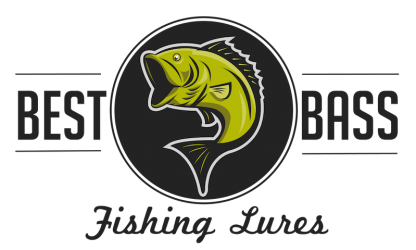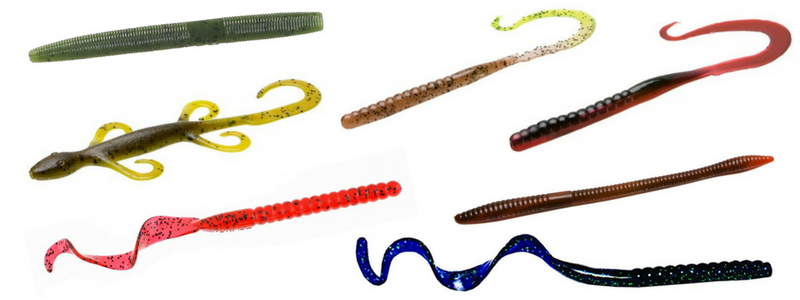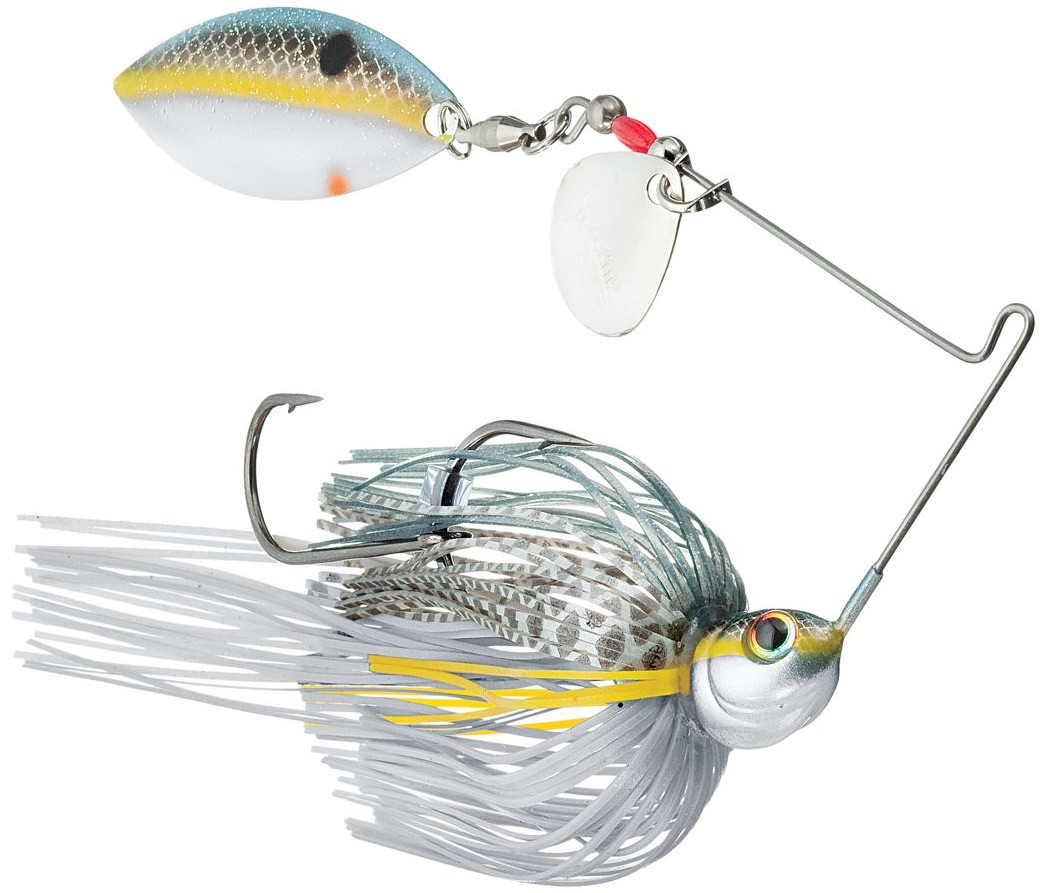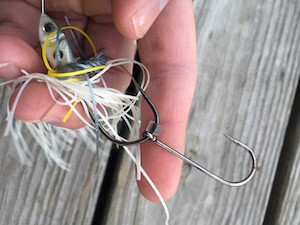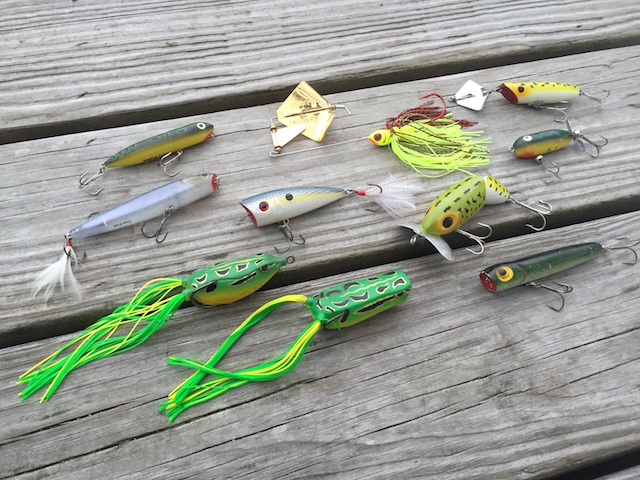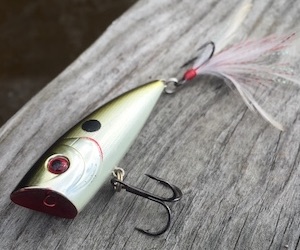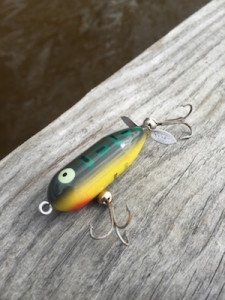The amount of bass lures on the market today is overwhelming to most anglers, let alone beginners. There are so many different styles, sizes, and colors that it’s nearly impossible to know where to begin without some guidance.
For example, if we knew nothing about bass fishing would we ever think a spinnerbait would look like an appealing meal to a fish? There’s nothing natural looking about it yet it’s one of the best bass lures out there.
So if you’re looking to start filling your tackle box with lures that are going to help you begin bass fishing, then the lures on this page will give you a solid base and get you started in the right direction. And even though this list of lures are excellent starter lures, you will still use them even when your skills improve.
1. Plastic Worms
There is no better way to begin bass fishing than with a rubber worm. Thats because there is no wrong way to fish it. Of course there are better ways than others but really anybody can cast a rubber worm and have a great chance of catching a bass.
The hardest part for beginners is rigging a plastic worm, but it doesn’t take long to master. The two rigs you should start with are the Texas rig and/or the Wacky rig. They are both great ways to present rubber worms but the Texas rig is more weedless, so if your casting accuracy isn’t great yet you won’t get hung up in areas you didn’t mean to cast to and lose your lure.
Plastic worms can be fished anywhere at any time, literally, but you should take full advantage of their weedless properties. Bass love cover and one of their favorite forms of cover are weeds, like lily pads, hydrilla, and different underwater grasses. They especially like to hang around the edges of cover like this. Bass use cover to ambush their prey, so when your worm enters that zone its swimming right through their prime hunting territory.
Try casting a rubber worm into a patch of lily pads, land on one of them if you can. Let it sit there for a couple of seconds then gently pull on the line to make the worm fall off the edge. The next few seconds, as the worm slowly sinks, is when your going to get majority of your strikes. If you don’t get one, try to get it back up on a lily pad and repeat the process. You also want to make sure you fish the edges of the whole lily pad patch before moving to a new spot.
That method is great for any kind of top cover like lily pads, thick grass thats bent over, or even logs. If your fishing more sparse weeds like thin grass, you want to bring the worm right through it and cast around the outer edges of the weed lines.
Do this by slowly raising the rod tip and then lowering it while reeling in the slack. This makes the worm swim up and down. When you lower the rod tip let the worm sit for a few seconds on the bottom.
While the worm is sitting on the bottom and when its sinking is most likely when it will be struck. It’s because of this that the most important rule of worm fishing is keeping the line tight. Worm fishing is all about feel, and if you leave a lot of line slack between you and your worm your not going to feel the soft vibration made from the bass picking up the worm.
Slack line will also have a negative effect your hookset and a solid hookset is crucial in worm fishing. Setting the hook is done by pulling the rod back towards your body fast and hard to get the hook to pierce the lip of the bass. If there is too much slack in the line you will not get a good hookset, and that’s if you even feel the bite at all. Within the first second or two you feel the worm get taken you need to set the hook.
There’s no doubting the fact that rubber worms are the best way to start bass fishing, and as your skills develop you can start fishing them with more advanced methods. The Texas rig is the best rig to start out using. Not only is it perfect for beginners but it’s a rig you will use for ever. The best worm to start with is a Senko style worm.
2. Spinnerbaits
The reason a spinnerbaits is such a great bass lure for a beginner is it doesn’t require a ton of expertise or finesse to be successful with one. Essentially all you do with a spinnerbait is cast it out and reel it straight in.
Spinnerbaits are considered a “power fishing” lure. Which means they’re retrieved much faster than other lures, for example, a worm or a jig.
This is a big advantage because it allows you to cover a lot of water in a shorter period of time. You don’t have a choice in the matter because if you stop reeling a spinnerbait it stops performing.
As you reel in your line the blades of the bait flutter and spin, creating a flash and vibration that attracts bass. You need to reel until you start to feel the vibration in your rod handle, thats when you know your retrieving it fast enough to make it perform.
Because this is such a fast moving bait, bass will sometimes come up short when trying to bite it. Some come equipped with a trailer hook, or you can add one yourself. This will help hook up those short strikes.
Spinnerbaits are somewhat weedless since the blade guards the hook from getting hung up, but you won’t get it through really thick weeds. The best thing to do is work it right along the weed edges in an attempt to draw bass out, this is how they ambush their natural prey.
Another plus for beginners is its easy to fish a spinnerbait at different depths by simply raising or lowering your rod tip during the retrieve. To fish it deep, let it sink when you cast it then reel it in with the rod tip low to the water’s surface.
Fishing it closer to the surface is just the opposite, start reeling as soon as it hits the water and keep the rod tip straight out, parallel to the water. You can also keep your rod tip high and get the lure to run just below the surface. The blades will disrupt the surface and create a little more attraction to itself.
Since you’re just starting out, a smaller sized spinnerbait like the Pond Magic Spinnerbait is perfect novice bass anglers. Smaller spinnerbaits get more strikes than the bigger ones, which is true for most lures actually. They may get you more small bass but catching more bass in general will build your confidence in spinnerbait fishing. And don’t think a big bass won’t hit a small lure too.
3. Topwater Lures
Once you catch a bass with a topwater lure, you will be hooked. It just may be the most exciting way to catch bass. For a fisherman, there’s nothing quite like seeing a fish break the surface to attack your lure.
Topwater lures are lures that run along the water’s surface, attracting bass below with noise and water disruption. There are many different lures that fall under the category of top water, while having completely different appearances and action from one another.
Some topwaters are fast moving, some walk side to side, and some barely move at all. All topwater lures float, with the exception of the buzzbait. They rely on a quick retrieve and a raised rod tip to keep them on the surface.
The only downside to topwater fishing is that bass sometimes miss the lure when they attempt to hit it, especially the fast moving ones. Let’s look at a couple good topwater lures for beginners.
A. Popper Lures
One of the original topwater lures, and still used today, are poppers. Poppers are great for beginners because they are very simple. All you do is cast them out and let them sit. Every so often you jerk your rod tip to make the cup on the face of the lure disrupt the surface and make a “popping” noise.
There is no rule of thumb for how often you “pop” the lure. Really it depends how active the bass are at that time. Sometimes three second pauses will trigger strikes while other times slowing down to 20 second pauses will do it. And sometimes a constant chugging action will get it done, where you barely pause between rod jerks.
A nice popper lure to start out with is the Rebel Pop-R. They’re just the right size for starting out at two and a half inches long and a quarter ounce in weight. And even though they are small you can cast them a mile because of their shape.
B. Prop Baits
Another great group of topwater lures for beginners are propeller lures, also known as prop baits or torpedo lures. These lures have a propellor, or sometimes more than one, that are powered by the waters resistance as they are pulled through the water.
The rotating propellor makes a rippling sound as it disturbs the waters surface, a combination that grabs the attention of bass. Casting it out and retrieving the lure in a straight retrieve is the basic way to fish it, and should be the first method you try.
If that method doesn’t seem to be getting any action then try a stop-and-go retrieve, where you reel it in for a bit then pause and let it float for a couple seconds, then continue reeling.
A third method you can try is pulling the rod tip towards you to make the lure travel in quick bursts. In between “bursts” let the lure float there for a second as you reel in the slack line. Sometimes this can trigger a strike even when fish are in active.
Heddon is a lure company known for their topwater baits, and they deserve that reputation. They’ve been producing top notch topwater lures for decades. Their Torpedo Lure is an excellent prop bait and a great start starting point for a beginner.
